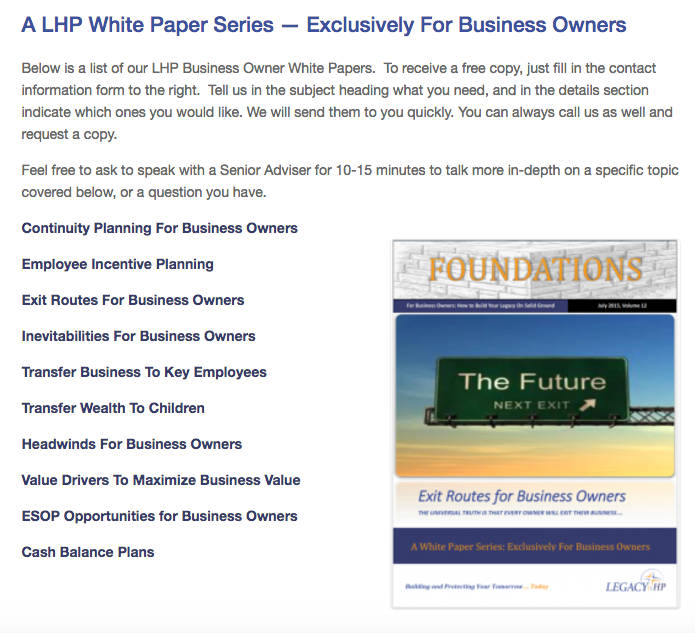Parents normally want to give equal amounts of their estates to their surviving children, regardless of how active each child is in the business. The problem with including this provision in a will is that each child may get not only an equal amount of the business, but also an equal amount of the non-business assets.
This arrangement ignores the fact that the owner may have already given large portions of the business to the business-active child; it also ignores a typical planning objective of giving the entire business interest to those children active in the business, while giving the rest of the children a disproportionate share in the balance of the estate.
Aurora Scaffolding rented and installed scaffolding systems on commercial sites. Like many construction-related firms, its economic fortunes rose and fell with unnerving regularity. However, its founder, Mike Jones, was a survivor – not only of the ups and downs of his business, but of a disabling injury at age 51. That experience made him a true believer in the estate planning process. Consequently, he found himself in his advisor’s office shortly after his release from one of the local hospitals.
Mike arrived with a list of objectives he had carefully prepared. He wanted to begin an immediate transition of management – and ultimately control – to his youngest son, Patrick, who had been working in the business for almost five years. Mike was motivated not simply out of a desire to benefit Patrick, but more importantly to provide a mechanism for getting money out of the business for Mike’s own benefit upon his planned departure in five years. There were no other likely candidates to buy his stock, so the fact that Patrick wanted to eventually own the business enabled Mike to make that decision earlier than he had planned.
Because Mike had neglected to obtain adequate disability income insurance, his second objective was to ensure that he would have adequate monies available to him in the event of another disabling injury.
Mike also described his other objectives (which happened to be estate planning based) as being the following.
- He wanted to provide a comfortable income for him and his wife, Sharon, during his lifetime. Mike also wanted that income to continue for Sharon in the event of his death.
- Primarily at her insistence, he wanted to provide an equitable distribution of the estate to his other son after both he and his wife died.
- Finally, he was reluctant to pay any estate taxes.
These concerns are typical of most business owners – retirement income, disability income, family income for surviving family members, fair distributions of the family’s estate among children, and minimization of estate taxes. Aren’t these also your concerns?
Mike’s Exit Planning Advisor began addressing his concerns by structuring them within The Seven Step Exit Planning Process™ – Setting Exit Objectives, Determining Business Value, Maximizing Business Value, Transferring Ownership and Other Financial Resources, Business Continuity, and Personal Wealth and Estate Planning. This comprehensive process is driven by Step One – Setting Exit Objectives. Mike’s advisor specifically approached his questions above in regard to his estate plan by first quantifying Mike’s objectives and creating a comprehensive Exit Plan that included meeting his stated lifetime objectives, as well as his estate planning objectives.
Creating a Comprehensive Exit Plan
To see how Mike and his Advisor Team created a comprehensive Exit Plan that not only included his estate plan, but also addressed the issues associated with distributing business and non-business assets to both of his business active and non-business active children, let’s revisit the hypothetical Mike Jones case study.
Mike and his wife lived comfortably, but not lavishly, on his salary of $200,000 per year. He wanted to maintain this income amount as long as he lived. At Mike’s death, his wife could live comfortably on $120,000 per year. Mike’s Advisor Team first reviewed his estate. Mike’s simplified balance sheet looked like this:
Fair market value of business.....................$1,000,000
Net equity in building........................................$500,000
Net equity in residence....................................$250,000
Outside liquid investments..............................$250,000
Life insurance................................................$1,000,000
Mike’s total estate, for estate tax purposes was $3 million. Concentrating on the estate tax issues, Mike decided to give his business active son, Patrick, 49 percent of the business, worth $325,000, (using a minority discount) in order to remove half of the future appreciation of the business from Mike’s estate. He also entered into a deferred compensation agreement with the company. The agreement provided for a $50,000 annual payment to Mike if he terminated employment for any reason other than his death. In that case, his estate would receive nothing under the deferred compensation agreement. The agreement was originally designed to run ten years. It is important to note that the payments totaling $500,000 to Mike and his family in effect replaces the “lost” value of one-half of the business via the gift to Patrick. After the deferred compensation plans were paid off, Mike also agreed to sell his remaining interest in the business to Patrick. They signed a purchase agreement with Mike to receive payments on the installment note for the purchase of his remaining interest — after the deferred compensation had been paid off.
Mike then entered into a buy-sell agreement with Patrick so that he and the business became obligated to purchase Mike’s stock if he left the company for any reason, including death, disability or planned retirement in five years. The purchase price was the fair market value of Mike’s remaining stock, worth $550,000 at present.
Next, Mike’s Exit Planning Advisor redesigned the Jones family estate plan. The advisor prepared an irrevocable life insurance trust and transferred all of the life insurance into it. The beneficiaries were Mike’s wife, Sharon, and both children. The oldest son, William, would receive the first $500,000 for the remaining trust estate at his mother’s death. Thereafter, the two sons would divide equally whatever amount was left, if any.
The $500,000 additional benefit to William is an attempt to equalize the lifetime gift to Patrick. We say “attempt” because if their mother lives for another 35 years (her probable life expectancy), William would not receive any money until then, while Patrick has enjoyed his gift for those 35 years.
On the other hand, when William does receive his share of the inheritance, it will likely be in cash or its equivalent, while Patrick receives his share in the form of closely held stock. This will bind Patrick to the family business, including all of the risks associated in owning a small business. His presence will provide the continuity of management required during the buyout of his father’s stock, as well as the payment of the deferred compensation.
Because Patrick is taking more risk, it can be argued that he is earning the stock given to him since he has agreed to stay on and provide a means for his father to receive money for his retirement or death — either through the stock sale or the deferred compensation payments
As illustrated in the Mike Jones case study above, it can be difficult to provide for fair distribution of your estate in the case of multiple children. The first step is to work with an Exit Planning Advisor to identify your lifetime and estate planning objectives, within the realm of your overall Exit Plan, and create an actionable plan that can be implemented within your specific timeframe.
If you have any questions about creating an estate plan prior to your business exit, please contact us to discuss your particular situation. We can help guide you through the process of creating an estate plan that not only helps meet your estate planning goals, but also supports your overall Exit Plan.
Take care and have a good day,
Michael
ABOUT LEGACYHP: Our passion is our mission -- To position our clients into a positive, energized, posture -- within your businesses and within your lives -- So that you manage change confidently, take decisive action, and enjoy life's journey Today... while you enjoy building your Legacy for Tomorrow.
Notice: The information contained in this article is general in nature and is not legal, tax or financial advice. For information regarding your particular situation, contact an attorney or a tax or financial advisor. The information in this newsletter is provided with the understanding that it does not render legal, accounting, tax or financial advice. In specific cases, clients should consult their legal, accounting, tax or financial advisor. This article is not intended to give advice or to represent our firm as being qualified to give advice in all areas of professional services. Exit Planning is a discipline that typically requires the collaboration of multiple professional advisors. To the extent that our firm does not have the expertise required on a particular matter, we will always work closely with you to help you gain access to the resources and professional advice that you need.



